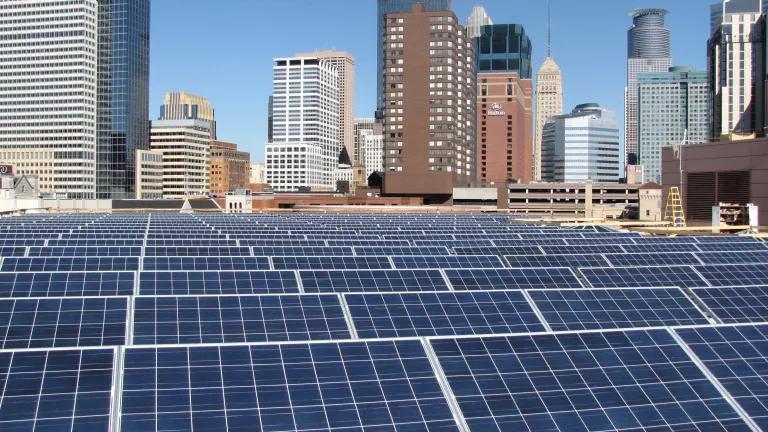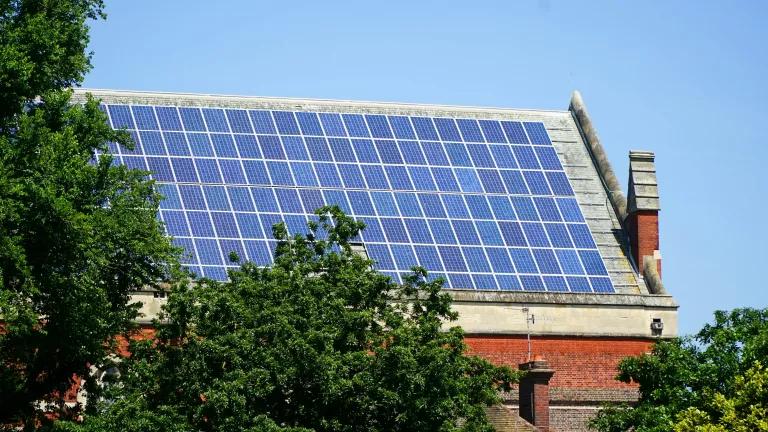Good News for Good Jobs: Clean Energy Soars
The just-released third annual U.S. Energy and Employment Report, a comprehensive look at energy jobs in America, showed once again that clean energy—especially efficiency—is the driving force behind job growth in this sector.

The just-released third annual U.S. Energy and Employment Report (USEER), a comprehensive look at energy jobs in America, showed once again that clean energy—especially efficiency—is the driving force behind job growth in this sector.
These jobs—like installing utility-scale solar energy projects, operating windmills, and manufacturing energy efficient equipment and appliances—pay more on average than the national median and are located all across the country from the coasts to rural communities and in the Rust Belt.
This report—published by the National Association of State Energy Officials and the Energy Futures Initiative with support from over a dozen states, organizations, and foundations picking up the Washington slack after the Trump administration’s inexplicable decision not to continue this research—uses the same methodology as seen in the previous two years of the U.S. Department of Energy job reports. The latest report shows the country had nearly 3.2 million Americans working in wind, solar, energy efficiency, and other clean energy jobs in 2017, outnumbering fossil fuel jobs 3 to 1.
The report is further reaffirmation that political leaders looking for ways to stimulate the economy should back policies that grow the clean energy sector, which also can help solve other problems in their communities by reducing unemployment, lowering harmful power plant emissions, and improving public health. Our sister organization—Environmental Entrepreneurs—provided this guide for Congress and states to take action on clean energy:

Take a Look at the Numbers
Who’s Got the Jobs?
The good news: Veterans as well as Hispanic and Latino workers make up a greater share of solar and wind jobs than their comparable national employment average. However, there is still work to be done to accelerate growth in this sector. In addition, the percentage of African-American and women employees in clean energy continues to be lower than the national average for their demographic, highlighting an opportunity to establish smart policies and initiate programs to help train and place workers to close this gap.

Energy Efficiency Is a Jobs Powerhouse
The energy efficiency sector employs 2.25 million Americans who work part- or full-time in this field and added the most jobs of any energy industry in 2017, reaching 67,000 new workers. Many of these jobs are in construction and manufacturing since energy efficiency requires boots on the ground to build, install, and maintain energy-saving products and systems in homes and buildings across the country. In fact, about 1 in every 6 construction jobs in the country is connected to energy efficiency.

Meanwhile, Energy Star appliance manufacturers employ more than 1 out of every 4 energy efficiency workers, suggesting that this voluntary federal energy efficiency program is a solid source of employment in addition to delivering billions of dollars in consumer savings.

Wind Energy Sails Forward
Wind energy companies employed more than 100,000 workers in 2017, an increase of approximately 6 percent over the previous year. Most wind jobs are in the construction and manufacturing industries, from skilled workers who build turbine components to technicians who work hundreds of feet above the ground to install and maintain wind towers.

Cleaner Cars and Batteries Spark Job Growth
More than one-quarter of the jobs in the motor vehicle industry—at least 650,000—are devoted to making cars cleaner, whether it’s improving fuel efficiency or building alternative fuel vehicles. More than 25,000 EVs were sold in March 2018 alone, requiring an increase in battery storage production that translated into a 12 percent increase over last year, adding nearly 6,000 new jobs.

Solar Slowdown Still 9X Faster than U.S. Economy
After increasing 168 percent over the last 7 years, solar jobs dipped 6 percent nationwide. Most of that decline was in California and Massachusetts, the states with the most mature solar industries. In 29 other states, both red and blue, solar jobs are still on the rise. The industry employed nearly 350,000 people in 2017, and expects a 5 percent increase in job growth in 2018. Solar energy alone employs nearly 4 times the number of workers in coal generation.
What’s Next?
Despite a White House energy plan that essentially ignores it, the clean energy industry is still driving job growth in the U.S. energy economy. More than 40 states in the nation today have a greater number of clean energy jobs than fossil fuel jobs. What’s next to continue the clean energy economy progress?
- States should establish strong policies, such as renewable energy and efficiency standards, clean vehicle expansion, and grid modernization to incorporate renewable energy.
- Localities should establish targeted programs and policies to train clean energy workers and link them to existing jobs.
- Congress must protect funding for clean energy innovation and efficiency at the U.S. Department of Energy and the U.S. Environmental Protection Agency and stop attempts to roll back clean vehicle laws. Lawmakers should also back tax credits for energy efficient buildings, extend the electric vehicle tax credit, and support low-carbon rural clean energy incentives that help avoid the need for increased natural gas pipelines and provide renewable and energy efficiency programs for these historically underserved communities.
- States, utilities, and stakeholders should work together to ensure that areas where fossil fuel plants are closing have a funded transition plan that protects communities and workers.
- Individuals can Take the Pledge and add their names to thousands of other business voices and workers who support clean energy and the policies that make it possible.
The vast majority of Americans agree: encouraging clean energy growth should be a national energy priority, and that the government should invest more in energy efficiency as well as wind and solar energy. Millions of Americans are already reaping the benefits of clean energy every day, not just in new jobs and new opportunities, but in cleaner air due to a reduction in the need to burn fossil fuels and lower energy bills.
With the increased frequency of Washington’s policies that undermine the clean energy economy, it’s up to states and localities to set stronger smart energy policies and make clean energy the way of life to improve their communities, save customers money, and benefit the environment.



